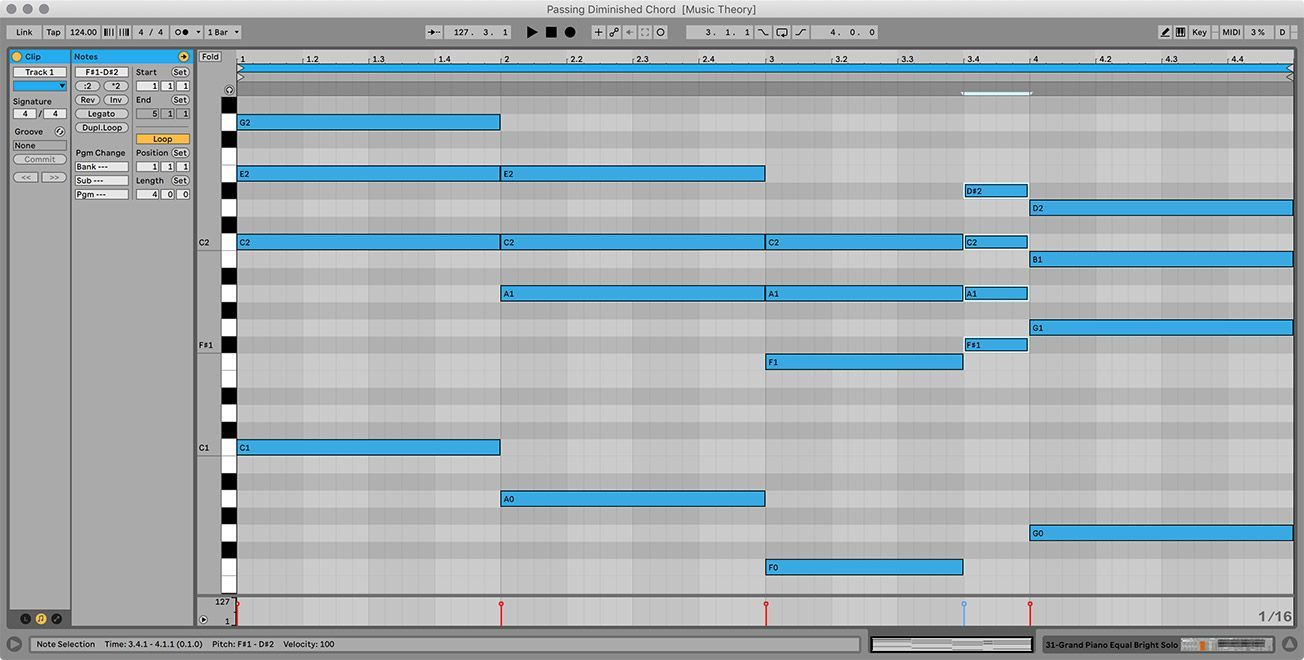What Is a Diminished Chord and How to Use Them
What is a diminished chord? Learn how to make diminished chords and use them to spice up your chord progressions in this basic music theory guide. Knowing how to use diminished chords will open creative doors and expand your songwriting.

What is a Diminished Chord?
A diminished chord is a triad built from the root note, minor third, and a diminished fifth. It’s a chord with two minor thirds above the root. Meaning three semitones separate the third and fifth notes of the chord.
For example, a C major triad has the notes C (the root), E (the third), and G (the fifth). Therefore, a diminished C triad has the notes C, Eb, and Gb.
Diminished chords inject a sense of drama, tension, and suspense into music. They also have a distinct timbre that sounds dark, dissonant, and eerie. Their oddness makes them unique!
However, the flattened fifth makes diminished chords sound unstable and creates a desire for tonal resolution. They leave the listener hanging, which makes the resolve back to consonant chords more impactful. This sense of tension makes them interesting chords to use in your progressions.
How to Make a Diminished Chord?

Diminished chords are easy to build because the note intervals are equally spaced by a third. Meaning each note in a diminished chord is separated by three half steps. Easy right?
There are three types of diminished chords: diminished triads , the diminished seventh , and the half-diminished seventh .
Let’s look at how to build these three chords using the key of D minor as an example.
1. The Diminished Triad (dim or °)
A diminished triad is a minor chord with a flat fifth. The chord symbols are “dim” and “°.” For example, Ddim or D°.
To build a diminished triad, first find the root note of the chord. The root is always the note that’s the basis for the chord. For example, the root note for a Ddim chord is D.
Next, count three semitones to find the third note of the scale. For example, the third note above the root in a Ddim chord is F.
Lastly, count three semitones from the third or six semitones from the root to find the diminished fifth note. For example, the fifth note in a Ddim chord is Ab. The complete Ddim triad chord has the notes D – F – Ab.
2. The Diminished Seventh Chord (dim7 or °7)
The diminished seventh is a four-note chord that consists of a:
- Root Note
- Minor 3rd
- Diminished 5th
- Diminished 7th
The diminished seventh (or fully diminished chord) adds a minor-third above a diminished triad. Meaning the seventh note is three semitones above the flattened fifth.
For example, the seventh note in a Ddim7 chord is Cb. Therefore, the complete Ddim7 chord has the notes D – F – Ab – Cb.
3. The Half-Diminished Seventh Chord (m7b5 or ø7)
The half-diminished seventh is a four-note chord consisting of a:
- Root Note
- Minor 3rd
- Diminished 5th
- Minor 7th
A half-diminished chord adds a major-third above a diminished triad. Meaning the seventh note is four semitones above the flattened fifth.
For example, the seventh note in a Dø7 chord is C. The complete Dø7 chord has the notes D – F – Ab – C.
How to Use Diminished Chords in Your Progressions

Diminished chords often function as passing chords in a progression. Passing chords spice up standard progressions and create tension between chords with a stronger relationship to the key.
A passing chord acts as a transition that sits “in-between” the primary chords of a progression. Typically, a passing chord is not in the same key as the song. As a result, it creates a dissonant sound that needs to resolve to a chord harmonically related to the song’s key.
The most common passing chord is the diminished seventh. Try adding a diminished chord in the middle section of your chord sequence. Then resolve it to a major or minor chord one half-step higher. This technique adds tension and intrigue to a chord progression while remaining melodic.
For example, try replacing the V chord in a standard chord progression with a Dim7 or m7b5 chord. If you have a common I – V – vi- IV chord progression, the diminished chord will play second.
However, diminished chords are not limited to replacing the V chord. You can use them anywhere within a chord progression. But, because diminished chords sound unstable, they rarely play on the first or last bar. You won’t find a sequence of diminished chords in a progression, either. They typically occur once for a beat or two within a chord progression. They’re passing chords, so they pass by quickly.
Where to Use Diminished Chords
To figure out where to use a passing diminished chord, find two chords a whole step apart. Next, build a diminished chord on the note between them. Lastly, put the passing chord between the two chords a whole step apart.
For example, let’s use the progression C – Am – F – G. The F major and G major chords are a whole step apart. The note between them is F#. Build a F#dim chord and put it between the F and G major chords. The new progression is C – Am – F – F#dim – G.
Diminished Chord Chart
You can play the diminished chord in all twelve keys. In major scales, a diminished triad occurs only on the 7th scale degree. Whereas in minor scales, a diminished triad occurs on the 2nd scale degree.
Below is a list of all twelve diminished triads for each key:
C dim = C – Eb – Gb
C# dim = C# – E – G
Db dim = Db – E – G
D dim = D – F – Ab
Eb dim = Eb – Gb – A
E dim = E – G – Bb
F dim = F – Ab – B
F# dim = F# – A – C
Gb dim = Gb – A – C
G dim = G – Bb – Db
Ab dim = Ab – B – D
A dim = A – C – Eb
Bb dim = Bb – Db – E
B dim = B – D – F
Example of Diminished Chord Progressions
There are several ways to resolve a diminished chord to either a major chord or minor chord. Leading a song into the vi chord is one common use of diminished chords -- not just in songwriting in EDM and pop music. The vi chord builds on the 6th scale degree of the key.
The song below uses a diminished triad in a major key following a V – vi – IV – I progression.
“Stay With Me” by Sam Smith
Sam Smith’s 2014 hit “Stay With Me” uses the G#dim chord in all three choruses and the bridge. Here is one of those rare examples where the progression starts on a diminished chord.
Listen to the chord quality of G#dim and how it leads into the last chorus repetition. It changes the emotional feel and sets up the final “stay with me” lyric at the end of the chorus. You’ll also notice how quickly the chord plays compared to the other chords. Can you hear the subtle differences?
[Chorus]
Won’t you stay with me?
Am – F – C
Cause you’re all I need
Am – F – C
This ain’t love it’s clear to see
G – Am – F – C
But darling, stay with me
G#dim – Am – F – C
The bridge follows the same chord progression but with different lyrics. It sets up the final chorus.
[Bridge]
Oh oh oh ohhh oh ohhh oh ohhh
Am – F – C
Oh oh oh ohhh oh ohhh oh ohhh
Am – F – C
Oh oh oh ohhh oh ohhh oh ohhh
G#dim – Am – F – C
Oh oh oh ohhh oh ohhh oh ohhh
G#dim – Am – F – C
Conclusion
Music theory tools like diminished chords expand the sounds you have available in your chord progressions. Using them in your songwriting will improve your overall sound and make your music more interesting.



